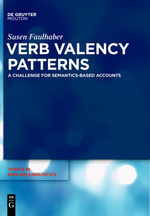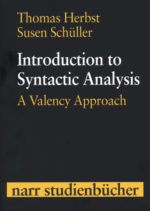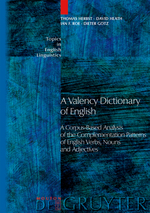Research and Outreach
Michael Klotz & Thomas Herbst
Berlin: Erich Schmidt Verlag, 2016, 287 pages, ISBN 978-3-503-16751-7, € 19,95
 English – the world’s most widely used language – has a large and varied dictionary market serving users around the world. The present introduction to English lexicography takes a linguistic perspective on English dictionaries, while at the same time putting great focus on the needs of the users and in particular foreign learners.Starting from the user perspective and the question of what makes a “good” dictionary, the book familiarizes the reader with a wide variety of English dictionaries and the characteristics which distinguish them. Topics such as dictionary structure, the information types of mono- and bilingual (English-German) dictionaries and a large number of specialized English dictionaries ranging from historical to learner’s dictionaries are thoroughly discussed and illustrated from a wide range of current editions of major English dictionaries. The relevant terminology of lexicography is worked into the discussion in individual chapters, however the number of terms introduced in this book is restricted to a manageable size. Although much of what is said in the book applies to print and electronic dictionaries alike, one entire chapter is dedicated to specific aspects of the quickly developing field of electronic lexicography. While the book’s main focus is on English dictionaries, many aspects of the linguistic description of the English language are also discussed with respect to their treatment in dictionaries. Readers will therefore also be introduced to the many characteristics of the English language itself.
English – the world’s most widely used language – has a large and varied dictionary market serving users around the world. The present introduction to English lexicography takes a linguistic perspective on English dictionaries, while at the same time putting great focus on the needs of the users and in particular foreign learners.Starting from the user perspective and the question of what makes a “good” dictionary, the book familiarizes the reader with a wide variety of English dictionaries and the characteristics which distinguish them. Topics such as dictionary structure, the information types of mono- and bilingual (English-German) dictionaries and a large number of specialized English dictionaries ranging from historical to learner’s dictionaries are thoroughly discussed and illustrated from a wide range of current editions of major English dictionaries. The relevant terminology of lexicography is worked into the discussion in individual chapters, however the number of terms introduced in this book is restricted to a manageable size. Although much of what is said in the book applies to print and electronic dictionaries alike, one entire chapter is dedicated to specific aspects of the quickly developing field of electronic lexicography. While the book’s main focus is on English dictionaries, many aspects of the linguistic description of the English language are also discussed with respect to their treatment in dictionaries. Readers will therefore also be introduced to the many characteristics of the English language itself.
Verb Valency Patterns – A Challenge for Semantics-Based Accounts
Susen Faulhaber
Berlin: de Gruyter Mouton, 2011, 357 pages, ISBN 978-3-11-024071-9, € 139,95
 Taking as its point of departure the general assumption that meaning is crucial in accounting for verb complementation, this volume presents the results of an empirical study of verb complementation patterns of semantically similar English verbs. The semantic parallels of the verbs selected are based on their coverage in dictionaries – first and foremost the Valency Dictionary of English (Herbst, Heath, Roe and Götz 2004) – as well as corpus research and native speaker assessments. It is demonstrated that despite obvious similarities in complementation between such verbs, there are still a significant number of syntactic discrepancies which cannot be accounted for on the basis of meaning alone and that semantic factors – such as selection restrictions and aspectual properties – do not sufficiently correlate with the verbs’ syntactic properties and consequently do not have sufficient explanatory power.
Taking as its point of departure the general assumption that meaning is crucial in accounting for verb complementation, this volume presents the results of an empirical study of verb complementation patterns of semantically similar English verbs. The semantic parallels of the verbs selected are based on their coverage in dictionaries – first and foremost the Valency Dictionary of English (Herbst, Heath, Roe and Götz 2004) – as well as corpus research and native speaker assessments. It is demonstrated that despite obvious similarities in complementation between such verbs, there are still a significant number of syntactic discrepancies which cannot be accounted for on the basis of meaning alone and that semantic factors – such as selection restrictions and aspectual properties – do not sufficiently correlate with the verbs’ syntactic properties and consequently do not have sufficient explanatory power.
Thus the results rigorously challenge so-called projectionist approaches which assume the position that complementation is determined by semantic properties and thus ought to be predictable on this basis. In the light of a general trend towards placing greater emphasis on semantic aspects, in the fields of construction grammar and cognitive grammar too, the number of idiosyncratic phenomena on the level of single complements as well as whole patterns clearly underlines the importance of storage phenomena as opposed to rule-based generation. As such it stresses the necessity of finding ways to systematically account for item-specific properties of verbs in any grammatical theory of the English language.
The book is targeted at all linguists interested in the relationship between semantics and syntax, which is one of the prevalent questions in modern linguistics, also in the field of construction grammar and cognitive grammar. Since the data is presented in a way which is compatible with various theories of complementation, the target group is clearly not restricted to any specific linguistic school. Because of the large amount of item-specific information presented, this book is also a valuable source for grammarians and lexicographers.
English Linguistics – A Coursebook for Students of English
Thomas Herbst
Berlin: de Gruyter Mouton, 2010, 368 pages, ISBN 978-3-11-020367-7, € 29,95
 The book introduces the reader to the central areas of English linguistics. The main sections are: the English language and linguistics – sounds – meaning-carrying units – sentences: models of grammar – meaning – utterances – variation. Notably, the book is written from a foreign student’s perspective of the English language, i.e. aspects relevant to foreign language teaching receive particular attention. A great deal of emphasis is put on the insights to be gained from the analysis of corpora, especially with respect to the idiomatic character of language (idiom principle, valency approach). In addition, the text offers basic facts about the history of the language and elaborates on the differences between British and American English.
The book introduces the reader to the central areas of English linguistics. The main sections are: the English language and linguistics – sounds – meaning-carrying units – sentences: models of grammar – meaning – utterances – variation. Notably, the book is written from a foreign student’s perspective of the English language, i.e. aspects relevant to foreign language teaching receive particular attention. A great deal of emphasis is put on the insights to be gained from the analysis of corpora, especially with respect to the idiomatic character of language (idiom principle, valency approach). In addition, the text offers basic facts about the history of the language and elaborates on the differences between British and American English.
The author demonstrates that a linguistic fact can usually be described in more than one way. To this end, each section contains a chapter written for beginners providing a broad outline and introducing the basic terminology. The remaining chapters in each section highlight linguistic facts in more detail and give an idea of how particular theories account for them.
The book can be used both from the first semester onwards and as perfect study aid for final B.A.-examinations.
Introduction to Syntactic Analysis – A Valency Approach
Thomas Herbst & Susen Schüller
Tübingen: Narr Verlag, 2008, 212 pages, 978-3-8233-6390-3, € 19,90
 This book provides an introduction to the analysis of sentences for students of English. It outlines principles of syntactic analysis and develops the categories used for a framework in which the concept of valency plays a major role.
This book provides an introduction to the analysis of sentences for students of English. It outlines principles of syntactic analysis and develops the categories used for a framework in which the concept of valency plays a major role.
The basic categories of syntactic description are elucidated in great detail: word classes, phrases, clauses. One major chapter deals with the notion of valency and how it can be implemented in a description of the English language. The main purpose of this book is to describe a framework which will enable students to scrutinise English sentences. The final chapter provides a practically oriented outline of how the categories identified in the preceding parts of the book can be adopted in an analysis of English sentences. The method outlined consists of eight clearly defined steps and is demonstrated in detail in the analysis of a number of autheintic English sentences.
A Valency Dictionary of English
Thomas Herbst, David Heath, Ian F. Roe and Dieter Götz. With the assistance of Michael Klotz
Berlin: de Gruyter Mouton, 2004, XLII, 961 pages, ISBN 978-3-11-017194-5, € 259,00
 This dictionary provides a valency description of English verbs, nouns and adjectives. Each entry contains a comprehensive list of the complementation patterns identified on the basis of the largest corpus of English available at the present time. All examples are taken directly from the COBUILD/Birmingham corpus. The valency description comprises statements about the quantitative valency of the lexical units established, an inventory of their obligatory, contextually optional and purely optional complements as well as systematic information on the semantic and collocational properties of the complements. An outline of the model of valency theory used in this dictionary is provided in the introduction.
This dictionary provides a valency description of English verbs, nouns and adjectives. Each entry contains a comprehensive list of the complementation patterns identified on the basis of the largest corpus of English available at the present time. All examples are taken directly from the COBUILD/Birmingham corpus. The valency description comprises statements about the quantitative valency of the lexical units established, an inventory of their obligatory, contextually optional and purely optional complements as well as systematic information on the semantic and collocational properties of the complements. An outline of the model of valency theory used in this dictionary is provided in the introduction.